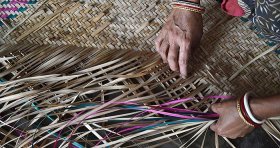August 24, 2018
Bangla’s heritage, madur set to go places with the setting up of Madur Hubs

Chief Minister Mamata Banerjee’s dream of creating an organised setup to help the propagation of madur, one of Bangla’s heritage crafts, and transform madur-making into a sustainable source of livelihood, is gradually becoming a reality.
Work is on in full swing to set up Madur Hubs in the districts of Purba Medinipur and Paschim Medinipur. Senior officials of West Bengal Khadi and Village Industries Board (WBKVIB), part of the State Micro, Small and Medium Enterprises (MSME) & Textiles Department, which works for the promotion of the traditional arts and crafts, said it will establish the madur manufacturing on a solid foundation.
Madur is a type of floor mat made by weaving together the dried stems of madur plants, found extensively in the two districts, with the help of cotton or jute threads.
The hubs will house training centres for the craftspeople to learn modern techniques and designs. Training will also be given to create mats for the international market.
With madur having got the Geographical Indication (GI) tag this year, the potential market for the product has increased manifold. Hence, stress is now being given on exports.
In India, there was always a certain market for these products. After the Trinamool Congress Government came to power, though, that market has been widening because of the active promotion of the craft. Consequently, the condition of the craft-makers has also improved much. Now, that market within the country is set to grow still, courtesy the GI tag.
Two institutions, one each in Purba Medinipur and Paschim Medinipur, have received the Government of India’s Craft Mark, which is a symbol of creativity in the national and international markets.
Being eco-friendly, the demand for madur is on the rise globally. It is used as room decoration in many European and African countries and in USA. The craftspeople are being invited to attend international fairs in many countries as well as in India (International Trade Fair in New Delhi, for example). Natural colours are being used to make the mats look more attractive.
A particular type of madur, called Masland Madur, is doing good business. It hails from the era of the nawabs of Bangla.
WBKVIB has published Madur Barta, a book containing information about the craft and success stories of the madur-makers. Success stories like those of Gourirani Jana, a craftswoman from Balichowk in Paschim Medinipur, who recently visited Kyrgyzstan to sell Masland Madur, or of Arun Khatua, a craftsman from Pingla, again in Paschim Medinipur, who has sold mats worth Rs 3 lakh at the International Trade Fair in New Delhi.
It may be recalled that after coming to power in 2011, Mamata Banerjee undertook schemes to revive the traditional products of Bengal like muslin, madur and masks (of north Bengal and Purulia). Earlier, many traditional craftspeople had left their professions because of financial constraints; now they have come back and are again eagerly involved in the production of their crafts.
Source: Millennium Post
